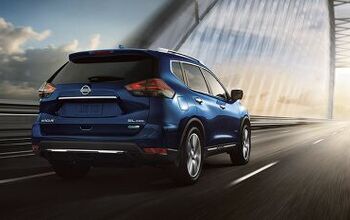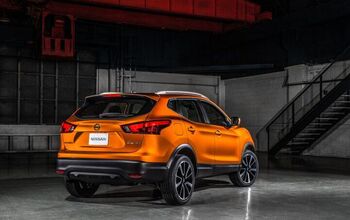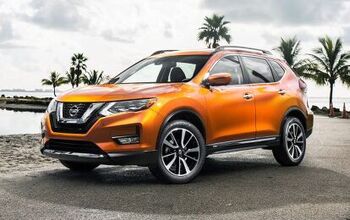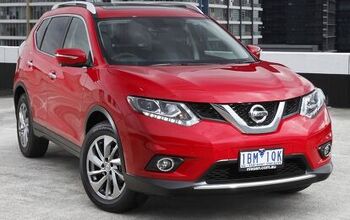The Nissan Rogue Hybrid Has Not Disappeared

Nissan’s a big fan of mid-year updates to its vehicles, and last week we told you of the changes coming to the 2018.5 Nissan Rogue Sport. Mainly, more standard safety features and a corresponding uptick in the small crossover’s entry price.
That piece led to the discovery that the model’s larger sibling, the fast-selling Rogue, seemed to have lost its hybrid variant — a model quietly introduced for the 2017 model year. Nissan’s consumer website shows no trace of the gas-electric compact CUV. Meanwhile, a search of Cars.com shows only 11 new Nissan Rogue Hybrids on lots across America, all of them 2017 models.
What’s the deal?
The Rogue Hybrid bowed with a 2.0-liter four-cylinder making 141 horsepower, mated to a 40 hp electric motor and a continuously variable transmission. From the outset, it was clear this was a model designed to undercut the hot Toyota RAV4 Hybrid in price. Going hybrid meant spending roughly $1,000 more than a conventional Rogue.
A flurry of reviews in the assorted blogs and buff books followed. Now, silence. The model persists at dealers, however, as Nissan sold 422 in March, and 1,165 over the first three months of 2018.
Be patient, says Dan Bedore, director of product communications at Nissan North America.
“The 2018MY Rogue Hybrid production has not begun yet, but is planned (very soon),” Bedore wrote in an email to TTAC. “When we are closer to on-sale date, we’ll release pricing and details.”
It seems the Rogue Hybrid will return to the public eye as a 2018.5 model, adding updates planned for the conventional Rogue. As Bedore says, it’s “mainly carryover,” but we can expect, among other things, an improved infotainment head unit.
Rogue sales have already topped the six figure mark this year, with sales over the first three months of 2018 totalling 116,454 — a 14.8 percent increase over the same period last year. Thank the Rogue Sport for that, as Nissan’s U.S. division lumps that model into the Rogue’s sales figures. Annoying, yes, but not for Nissan.
In its first full year of sales (2008), the Rogue nameplate moved 75,053 units in the United States. Last year, sales reached 403,465. Only the RAV4 moved more compact crossovers in the U.S., and the gap was perilously close — just a few thousand more.
In the hybrid field, Nissan faces growing pressure from Toyota, which decided to slash RAV4 Hybrid prices for 2018. It will be interesting to see what Nissan does with its own MSRPs.
[Image: Nissan]

More by Steph Willems
Latest Car Reviews
Read moreLatest Product Reviews
Read moreRecent Comments
- 28-Cars-Later I'm getting a Knight Rider vibe... or is it more Knightboat?
- 28-Cars-Later "the person would likely be involved in taking the Corvette to the next level with full electrification."Chevrolet sold 37,224 C8s in 2023 starting at $65,895 in North America (no word on other regions) while Porsche sold 40,629 Taycans worldwide starting at $99,400. I imagine per unit Porsche/VAG profit at $100K+ but was far as R&D payback and other sunk costs I cannot say. I remember reading the new C8 platform was designed for hybrids (or something to that effect) so I expect Chevrolet to experiment with different model types but I don't expect Corvette to become the Taycan. If that is the expectation, I think it will ride off into the sunset because GM is that incompetent/impotent. Additional: In ten years outside of wrecks I expect a majority of C8s to still be running and economically roadworthy, I do not expect that of Taycans.
- Tassos Jong-iL Not all martyrs see divinity, but at least you tried.
- ChristianWimmer My girlfriend has a BMW i3S. She has no garage. Her car parks on the street in front of her apartment throughout the year. The closest charging station in her neighborhood is about 1 kilometer away. She has no EV-charging at work.When her charge is low and she’s on the way home, she will visit that closest 1 km away charger (which can charge two cars) , park her car there (if it’s not occupied) and then she has two hours time to charge her car before she is by law required to move. After hooking up her car to the charger, she has to walk that 1 km home and go back in 2 hours. It’s not practical for sure and she does find it annoying.Her daily trip to work is about 8 km. The 225 km range of her BMW i3S will last her for a week or two and that’s fine for her. I would never be able to handle this “stress”. I prefer pulling up to a gas station, spend barely 2 minutes filling up my small 53 liter fuel tank, pay for the gas and then manage almost 720 km range in my 25-35% thermal efficient internal combustion engine vehicle.
- Tassos Jong-iL Here in North Korea we are lucky to have any tires.


































Comments
Join the conversation